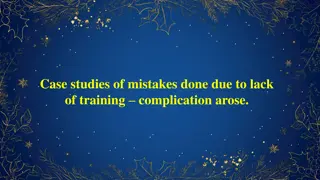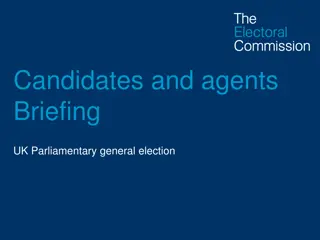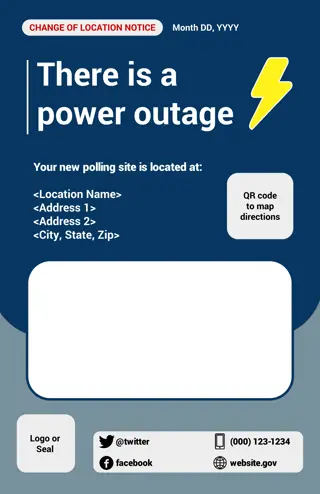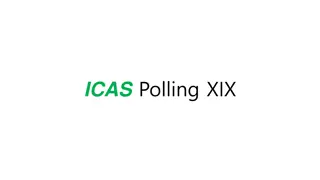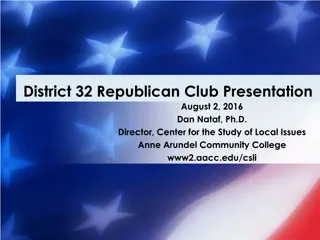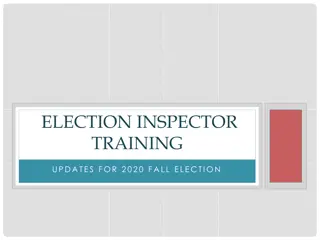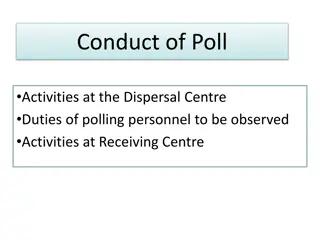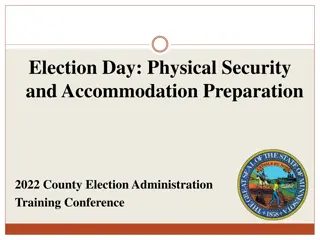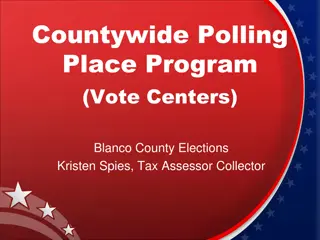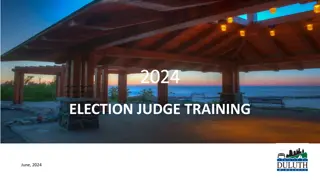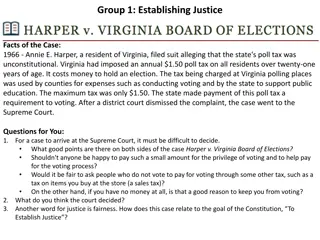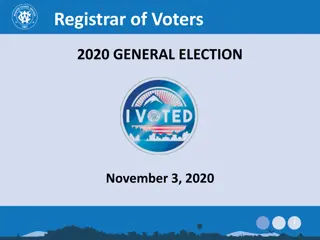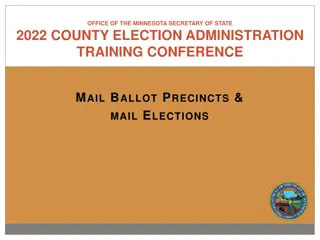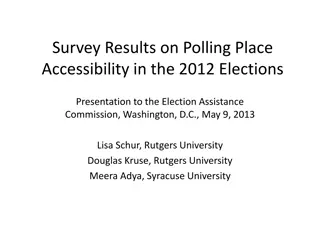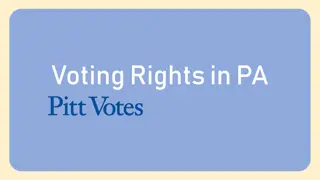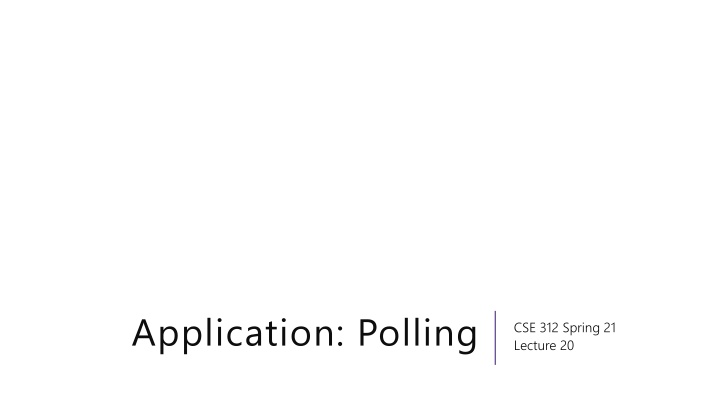
Polling in CSE: Exponential Distributions and Central Limit Theorem
Explore the concepts of polling in Computer Science Engineering through topics like exponential distributions, continuity correction, and the Central Limit Theorem. Learn how to analyze polling data and make accurate predictions. Get insights into probability calculations and sampling methods for accurate polling results.
Download Presentation

Please find below an Image/Link to download the presentation.
The content on the website is provided AS IS for your information and personal use only. It may not be sold, licensed, or shared on other websites without obtaining consent from the author. If you encounter any issues during the download, it is possible that the publisher has removed the file from their server.
You are allowed to download the files provided on this website for personal or commercial use, subject to the condition that they are used lawfully. All files are the property of their respective owners.
The content on the website is provided AS IS for your information and personal use only. It may not be sold, licensed, or shared on other websites without obtaining consent from the author.
E N D
Presentation Transcript
Application: Polling CSE 312 Spring 21 Lecture 20
Announcements Pset 6 deadline will be delayed to Thursday so you have at least 24 hours to take any Pset 5 feedback into account (coming this morning). Can still use up to 3 late days (through Sunday) Pset 7 comes out tonight, due Wednesday May 19 Real World 2 is still due on Monday.
Approximating a continuous distribution You buy lightbulbs that burn out according to an exponential distribution with parameter of ? = 1.8 lightbulbs per year. You buy a 10 pack of (independent) light bulbs. What is the probability that your 10-pack lasts at least 5 years? Let ??be the time it takes for lightbulb ? to burn out. Let ? be the total time. Estimate (? 5).
Wheres the continuity correction? There s no correction to make it was already continuous!! ? 5 ? 10/1.8 10/1.82 5 10/1.8 = 10/1.82 ? 5 10/1.8 10/1.82By CLT (? 0.32) = 1 0.32 = (0.32) .62552 True value (needs a distribution not in our zoo) is 0.58741
Outline of CLT steps 1. Write event you are interested in, in terms of sum of random variables. 2. Apply continuity correction if RVs are discrete. 3. Normalize RV to have mean 0 and standard deviation 1. 4. Replace RV with ?(0,1). 5. Write event in terms of 6. Look up in table.
Polling Our end goal is to answer the question how many people do I need to poll to get an accurate sense of how the population is going to vote? That s a weird question (it ll require going backwards in the algebra) so first we ll go forwards (given the poll size how accurate will we be?) to see what s happening more clearly.
Polling Suppose you know that 60% of CSE students support you in your run for SAC. If you draw a sample of 30 students, what is the probability that you don t get a majority of their votes. How are you sampling? Method 1: Get a uniformly random subset of size 30. Method 2: Independently draw 30 people with replacement. Which do we use?
Polling Method 1 is what s accurate to what is actually done but we re going to use the math from Method 2. Why? Hypergometric variable formulas are rough, and for increasing population size they re very close to binomial. And we re going to approximate with the CLT anyway, so the added inaccuracy isn t a dealbreaker. If we need other calculations, independence will make any of them easier.
Polling Let ??be the indicator for person ?in the sample supports you. ? ?? 30 We re interested in the event ? .5 . What is ? ? ? What is Var ? ? ?=1 is the fraction who support you. ? =
Polling Let ??be the indicator for person ?in the sample supports you. ? ?? 30 We re interested in the event ? .5 . What is ? ? ? What is Var ? ? ?=1 is the fraction who support you. ? = 1 30? ?? =.6 30 Var ? = 302Var ?? = 30=3 5. ? ? = 1 1 30 .6 .4 = 1 125.
Using the CLT ? .5 ? .6 1/ 125 .5 .6 1/ 125 = .5 .6 1/ 125 where ?~?(0,1) ? (? 1.12) = 1.12 = 1 1.12 1 0.86864 = 0.13136
Hey! Wheres the continuity correction? If this were just a question about ? = 30, we would have used one. But for preparing for the next calculation it made sense to skip it. What is ?? It s the average of a bunch of indicators. So the support is: 0 ?,1 Instead of .5, we d use .5 + And for real polling applications, ? is going to be quite big anyway where 1 ?,2 ?,3 ?, ,? 1 ?,? ?. 1 2?. Which makes the algebra much worse. 2? is not going to make a substantial difference.
Hey! You didnt tell us how many students were in CSE! The accuracy of a poll is dependent on the number of people you sample, not the size of the population.* Weird right? This isn t a trick of the fact that we used the CLT. The same is true if we calculated exactly with a binomial. *at least for this idealized scenario, where the answer is a simple yes or no and you can get a uniformly random person. Those things become less likely as populations get bigger.
The Reverse Question Polls are made by sampling ? people from a population. They are then reported with 52% of likely voters would vote in favor of proposal if held today (margin of error +/- 3%) You are going to run your own poll. And you want a better margin of error you want 2% how many people do you need to poll? Let s think about idealized polling pretend we re really getting a uniformly random person.
Margin of Error Wait what s a margin of error The result of the poll is a random variable it has a distribution. You d like to know something about its variance (Did you poll everyone in the entire country? Just 3 people? How much variance is there in the poll?) A margin of error is an intuitive measurement of the variance of the poll. If I performed this poll repeatedly, 95% of the time, we re within true +/- the margin of error.
Our Goal Set a target I want my margin of error to be 2%. That is, at least 95% of the time, your poll s estimate of the fraction of people in favor will be within 2 percentage points of the true value. So how many people are you going to need to interview?
Poll Setup Let ?? be the indicator that the ?th person you interview supports the proposal. Your random variable is ?: ??/? Let ? be the true fraction of people who support the proposal. What is the ? ? = Var ? =
Poll Setup Let ?? be the indicator that the ?th person you interview supports the proposal. Your random variable is ?: ??/? Let ? be the true fraction of people who support the proposal. What is the 1 ? ? ?? =?? 1 ?2Var ?? =? 1 ? ? ? = ?= ? Var ? = ?
Using the CLT What are we looking for? Well we have a margin of error: ? .02 ? ? + .02 .95 That says we re within the 2% margin of error at least 95% of the time. What is that probability? Well let s setup to use the CLT. Subtract the expectation and divide by the standard devation. ? ? ?(1 ?)/? ? .02 ? ?(1 ?)/? ?+.02 ? .95 ?(1 ?)/?
Apply the CLT ? ? ?(1 ?)/? ? .02 ? ?(1 ?)/? ?+.02 ? .95 ?(1 ?)/? ? .02 ? 1 ? ? ? .02 Is well approximated by .95 for ?~?(0,1) ? 1 ? So as ? changes, the probability changes. So choose the smallest ? for which the probability is at least .95 WAIT, what s ? 1 ? ? We don t know ?. That s whywe re doing the poll in the first place.
Handling ? 1 ? Justification 1: Justification 1: If we make a mistake, we want it to be making ? bigger. (since we re trying to say take ?at least this big, and you ll be safe ). The bigger the standard deviation, the bigger ? will need to be to control it. So assume the biggest possible standard deviation. Justification 2: Justification 2: As ? 1 ?gets bigger, the interval gets smaller (it s in the denominator), so assuming the biggest value of ? 1 ? gives us the most restricted interval. So no matter what the true interval is we have a subset of it. And if our probability is at least .95 then the true probability is at least .95. What s the maximum of ? 1 ? ?
Worst value of ? Calculus time! Set ? ?? 1 ? ?21 2? = 0 1 2? = 0 ? = 1/2 Second derivative test will confirm ? =1 Or just plot it. ? ?2= 0 2 is a maximizer 1 21 1 1/4. = 2
Doing the algebra ? ? ?(1 ?)/? ? .02 ? ?(1 ?)/? ?+.02 ? ?(1 ?)/? ? .02 ? 1 ? ? ? .02 by CLT; ?~?(0,1) ? 1 ? ? .02 ? .02 ? 1/4 1/4 = .04 ? ? .04 ? = .04 ? 1 .04 ? = 2 .04 ? 1 2 .04 ? 1 .95 .04 ? 1.95 2
Using the -table .04 ? .975 -table says: .04 ? 1.96 ? 49 ? 2401. gives 95% confidence interval of +/- 2%. I.e. 95% of the time, our poll gets a value within 2% of the true value.
CLT Wrap-up It s not ideal that we had an approximation symbol in the middle (that isn t really a guarantee at this point, it s an approximation) Observation 1 Observation 1: with our current tools, we wouldn t get an answer in a reasonable amount of time. But using a binomial would be even harder. As ?changes, the distribution of a binomial changes. Wolfram alpha isn t even enough here (unless you have 2+ hours to spare to guess and check values). You need a computer program to get the exact value. You re computer scientists! You can write that program. But it takes time. Observation 2: Observation 2: if you need an absolute guarantee, you won t get one. The tool you want is a concentration inequality/tail bound. We ll see those next week.
CLT Wrap-up Use the CLT when: 1. The random variable you re interested in is the sum of independent random variables. 2. The random variable you re interested in does not have an easily accessible or easy to use pmf/pdf (or the question you re asking doesn t lend it self to easily using the pmf/pdf) 3. You only need an approximate answer, and the sum is of at least a moderate number of random variables.

